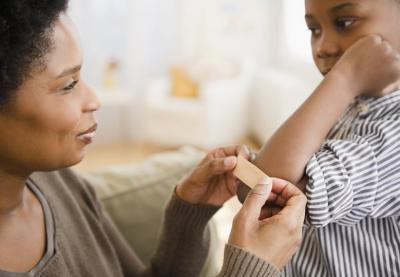Home Management of Minor Injuries and When to Seek Professional Care
As parents, we all do our best to keep our kids from harm. Eventually however, virtually every child experiences a minor injury of some kind. Fortunately, many of these boo-boos can be managed at home. Below is a quick reference guide to some types of injuries a child might experience—and how to care for them like a pro – as well as some telltale signs that an injury needs medical attention.

Cuts and scrapes
For small cuts and scrapes, rinse the wound with running water until clean. Do not apply hydrogen peroxide or rubbing alcohol. Scrapes likely need several minutes of rinsing, as they often have dirt and debris that you need to clean out prior to dressing the wound. Apply constant pressure with gauze or a clean cloth to stop bleeding. Apply an over-the-counter antibiotic ointment, and a bandage.
Check the wound, reapply antibiotic ointment, and change the bandage once or twice a day. Once the wound has formed a scab, you can usually leave it open to air. Contact your provider for any signs of infection – redness or warmth, pus, reopening of the wound, increasing pain, or fever.
Many wounds will leave some degree of scarring. However, children’s skin typically heals better than adults, and over time the scar may fade. Once the wound is healed (about 2 weeks after injury), you should protect the scar by applying sunscreen SPF30 or higher whenever it is exposed to the sun. Do this for at least 6 months. Silicone sheets or gels are also available as over-the-counter scar reduction therapies. They are often applied 1-3 times daily, for several weeks to months, and may help smooth out the texture of a scar, and help the skin return to its baseline pigmentation.
Signs that a cut may need stitches
In general, a cut likely needs medical attention if:
- It is deeper or longer than half an inch
- It is gaping (meaning you can bring the wound edges together with your fingertips, but they open again when you release them)
- It has a foreign body in it (an object or debris that you cannot easily remove yourself)
- You can see fatty tissue or muscle
- You cannot control the bleeding
- It is on the face, or any other location in which you are concerned about cosmetic outcome
Some cuts may require a tetanus booster, so you should contact your provider if you are unsure of your child’s vaccination status.
Punctures and splinters
Small, superficial splinters can often be removed with tweezers. If you are unable to easily grasp the end of a splinter to remove it, have your child soak the area in warm water several times a day. This may help soften the skin, so that you can more easily access the splinter. If the splinter is wide, deep, or causing your child pain, contact your provider for assistance with removal. Do not try to dig the splinter out using a needle or other sharp object.
Any puncture wound beyond a small splinter should be evaluated by a medical professional, as a tetanus booster may be needed. Do not attempt to remove a large object (such as a stick or a rod) from a wound. These types of objects should be removed in the emergency department only.
Bruises
For minor bruises, apply a cool compress or ice wrapped in a clean cloth (do not apply ice directly to the skin). The cold temperature and slight pressure help to reduce pain and swelling. This can be helpful for up to 24 hours after an injury – the general rule of thumb is 20 minutes on, 20 minutes off. For large bruises, crush injuries, significant pain or swelling, or a bruise associated with a head injury, call your provider.
Bites and stings
For an insect sting, use a hard, fine edge (such as the edge of a credit card) to remove the stinger as soon as possible. Rinse the area with cool water and apply a cool compress. Some people can have an allergic reaction in response to an insect sting – call your provider if the area is increasing in redness, swelling, pain, or itching, or if you notice a localized rash developing. For widespread rash, difficulty breathing, swelling of the mouth/lips/tongue, or vomiting, call 911.
For human or animal bites, wash the wound thoroughly with soap and water. Contact your provider for any bite wound – your child may need a tetanus booster, rabies shot, or antibiotics. If it is a large injury or you cannot control the bleeding, call 911.
Hopefully, you will never have to use the tips in this article. However, if you do, let me reassure you from one parent to another – I am certain you will do great! Especially once you give your child’s boo-boo a kiss. If you have any questions about an injury, do not hesitate to call for an appointment. We are always happy to help.
